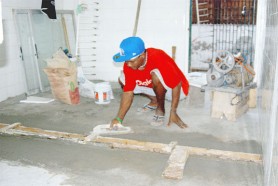The unusual high tide that savaged Guyana’s coast and riverain areas last week has brought to light–at least for one group of business people– the urgent need to remodel the structure of their business places, and time may not be on their side as more high tides loom.

An onslaught of more than three metres high waves on Thursday, September 9, flowed over the wharf area of Stabroek Market that extends over the Demerara River and through the inland section of the market, exacting a heavy toll on businesses, especially those in the dry goods trade. Damage was believed to be greatest among stores in the inland area just south of, and closest to, the wharf, where the item of trade is mostly clothing, bales of cloth and the fittings that go along with them.
Owner-operators of these stores who complain of damage to the tune of millions of dollars see the only solution to be City Hall allowing them to build second storeys for their stalls, so that goods can be rapidly packed upstairs and out of the reach of water, should they be hit by another unusual spring tide. “I think the market [authority] should give us permission to build on top,” Maria Thomas told Stabroek Business. She estimates her losses to be $1.5 million in damaged goods. Now, she fears leaving stock on the floor of her one-storey stall overnight.
Thomas’s view, which was common among other vendors, is also supported by Clerk of Markets Schulder Griffith. He estimates total losses to business people in the market to be in the vicinity of $10 million and he spoke of plans to ensure that goods are not packed on the floor of stalls.
The two ways he sees this being done is to have stall holders place their merchandise on at least two palettes that are used to transport goods or store major items on the second floor. Current regulations, however, do not allow erection of upper storey storage bonds for every stall. Wherever applicable, the authorities intend to permit the building of a second-storey storage bond. “That can’t happen in the entire market,” Griffith explained.
Grocer C. Surujballi, who has a second storey storage bond, considers himself fortunate to have suffered only $50,000 in damage when compared to other stallholders. “My floor is a bit high, so when we saw the water coming we just moved things upstairs.” His grocery stall is also farther inland, compared to the clothing and cloth vendors.
Owing to the nature of her business, jeweller Sharda Jaipersaud, was also among the lucky. Explaining that she has all her jewellery transported out of the stall by close of business, Jaipersaud said she was already out of there when the floods came Thursday evening. She does not see closure of the market the following Friday and Saturday as loss of business for her because she did not want to be there. “I just wanted to close because the [clean-up] need was too much.”
On the other hand, Andrew Persaud, who runs two clothing and garment stalls, estimated his losses to flood waters at $1.5 million to $2 million. “I could not give an exact figure. I packed away about 10 large garbage bags of damaged stock to throw away.”
B.J. Balgobin thinks his losses are in the vicinity of $2.8 million. In addition to the market-wide grant for stalls to go to two storeys, he wants the city authorities—with help from central government–to raise the concrete floor level on the inland section of the market.
In addition to losses stemming directly from damaged merchandise, Maria Thomas said that she lost some $500,000 in sales because of the three-day closure of the market, beginning Thursday, and unavailability of goods required by shoppers when business resumed. “Right now, baby, we are out and will get back stock tomorrow,” she said to a shopper during the interview, with Stabroek Business. “We have creditors who we have to pay. The creditors still look forward for their money. We can’t tell them stock is damaged and we can’t pay,” she commented.
As much as vendors are clamouring for permission to have a second storey erected over their stores, they are fearful it will come at a higher rental or market tax.
C Surujballi said that it was just some weeks ago that he took over his current business location, previously known as the ‘Ice House,’ where Wieting and Richter sold ice. The Ice House rent for one storey was $22,000 per month, but now with his storage bond placed atop the rent has gone up to $33,000.
Meanwhile, Griffith said steps are being taken to ensure the impact on business persons is not again so severe in event of another unusual spring tide. Those steps will take on some urgency as the coastland has a history of severe spring tides close to the end of the year. “Remember it’s another spring tide in October. Next month we got a next flood,” warned Maria Thomas.





